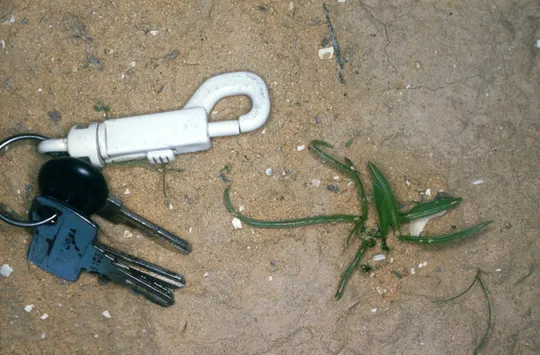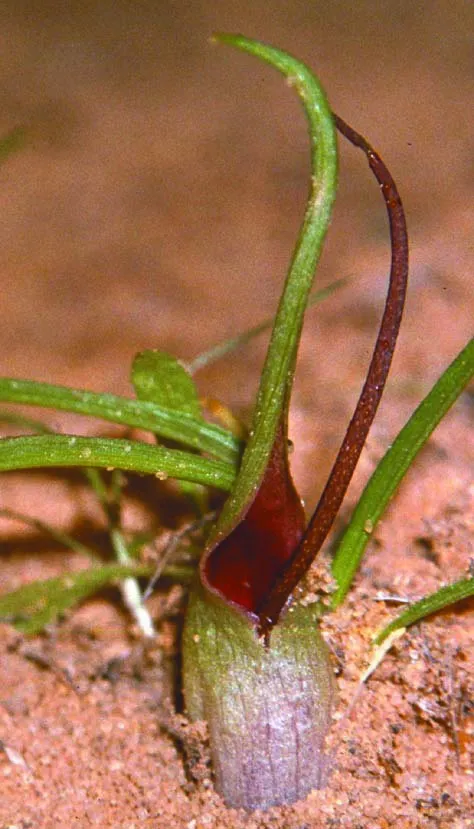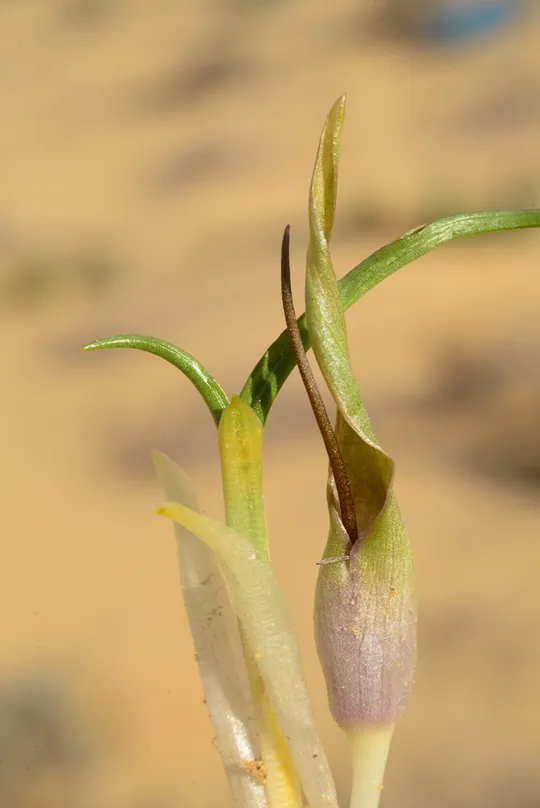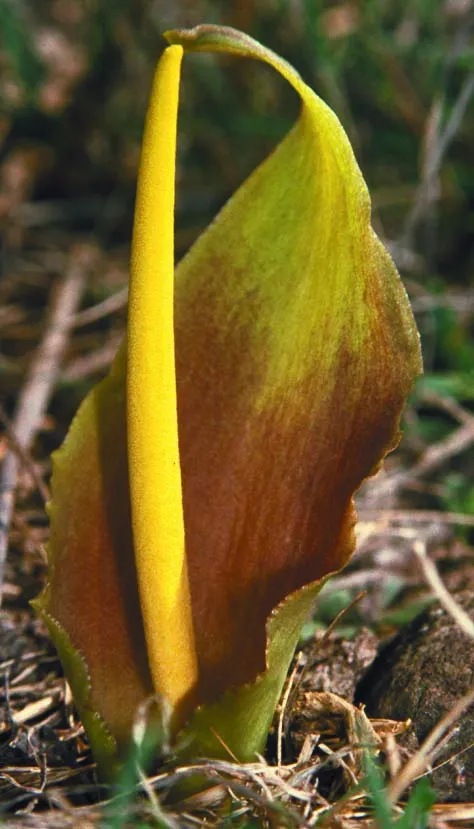Tiny Biarum
Biarum olivieri



Biarum olivieri is a geophyte that flowers early in winter. Its thick, annual tuber is subterranean: every year the winter leaves form new tubers over the shrinking old ones. The linear grooved leaves are 1-1.5 cm wide, similar to Poaceae or Liliaceae leaves are arranged in a long narrow rosette. Biarum olivieri flowers in November-December, after the rain and after new leaves sprout. Its inflorescence is similar to the inflorescence of Arum but it is very small and close to the sandy soil. The inflorescence is enveloped in a spathe that has a jug-like base, which encloses the stalk-like spadix. The female flowers are arranged at the base of the rachis and the male flowers are above them. Most of inflorescence jug is concealed in the sand only the top of the spathe protrudes above the ground; most of the time it droops over the jug opening and covers it. The fruits ripen inside the ground.
Currently grows only in the northern Negev in three sub-regions: 1. Mishor Yamin, where the largest population grows, 2. In the Mash'abe Sadeh Reserve and Agur Sands (Yoav Gertman) and 3. In the Sekher Sands near Ramat Hovav. A Hebrew University Herbarium specimen was collected at the site by Tuvia Kushnir in 1942 and a number of observations were also recorded, but in recent years (from 1990 onwards), Biarum olivieri was not found there. Flora Palaestina, the Analytical Flora of Eretz-Israel (1991) and Danin (2004) claim the species was found in the Negev Highlands and in the lower Jordan Valley, but we were unable to verify this data, nor is there evidence in the work of Kobi Coach on Biarum. The species was also seen in northern Sinai in the Yamit area (ROTEM advanced study program, February 1982).
Stabilized sand dunes and sandy soil, mostly in extensive sand areas.
For the genus – see Biarum auraniticum.
Biarum olivieri is different from the other Biarum species in Israel: the spathe blade is narrower than its tube; the enclosing spathe usually droops hiding the inflorescence, while in other Biarum species the spathe is strictly upright. The ring of sterile flowers that separate the male and the female flowers is degenerate or missing; the leaves are linear. This is the only Biarum species in Israel that blooms at the same time, or after the appearance of leaves.
• Sandy soil is easily disturbed by mechanical means and the surface is easily damaged, destroying Biarum olivieri. Intensive grazing is also destructive.
• There are only three populations in the country and they are far apart. Between the Mash'abim Sands site and the Agur Sands site there is a sandy desert continuum, which could allow seed and plant migration. This, however, is not the case in the Mishor Yamin Sands which are isolated from the western Negev sand block. Biarum is not found in the Aravah sands, possibly due to the extensive fragmentation.
• Large annual fluctuations in population size were observed and documented, probably a result of the large variations in precipitation. In the Mishor Yamin and the Mashabim sands hundreds of plants were counted in 2003 and only a few in other years. The Sekher Sands population near Ramat Hovav probably became extinct as a result of grazing pressure and disturbance by local residents.
• The conservation status of populations in Egypt is unknown, but as the country possesses vast areas of untouched sands, it is unlikely that the species is in globally threatened.
• Both the Agur Sands and the Mash'abe Sade site are situated within the boundaries of nature reserves, but these are subject to grazing, road construction and the like. The Mishor Yamin site is near the area belonging to the Dimona nuclear reactor and the Nuclear Research Center should invest in fencing and preservation of the species in spite of, and because these areas are not declared nature reserves.
Areas with large populations should be fenced and controlled grazing should be implemented to restrict competition from other herbaceous annuals.
A species endemic to Israel and Egypt.
A desert geophyte growing in sandy areas that blooms at ground level. A sub-endemic species to Israel and Egypt, unlike other Biarum species. A rare plant that grows only in the Mishor Yamin, Mash'abe Sade and Halutza Sands in Israel. Its locations are few and threatened because of the development of industrial zones in Mishor Yamin-Ef'e, settlement in the Halutza Sands and off-road vehicle activity.
כח, י. 1983.על הסוג אחילוף בישראל. רתם 6:
44-45.
כח, י. 1988. הלופיים בישראל רתם 25:
5-36.
Current Occupancy Map
| 1000 squre meter pixel | 5000 squre meter pixel | 10000 squre meter pixel | |
|---|---|---|---|
| number of observations | 0 | 0 | 0 |
| in total pixels | 0 | 0 | 0 |
| Family | Araceae |
| Classification | On the endangered species list |
| Ecosystem | Desert |
| Chorotype | Eastern Saharo-Arabian |
| Conservation Site | Mash'abim Sands Nature Reserve |
| Rarity |
1
3
6
|
|---|---|
| Vulnerability |
0
1
4
|
| Attractiveness |
0
0
4
|
| Endemism |
0
2
4
|
| Red number |
1
3.7
10
|
| Peripherality | S |
| IUCN category | DD EW EX LC CR EN VU NT |
| Threat Definition according to the red book | Vulnerable |
 Based on:
Based on:






